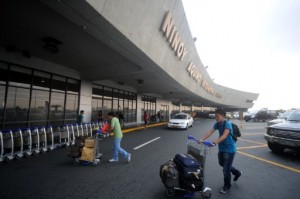At Naia, int’l airlines fight over tight space

Infrastructure bottlenecks continue to choke the aviation sector as more foreign carriers, unable to find slots in most major airports in the Philippines, are deterred from mounting flights to the country. AFP PHOTO
Infrastructure bottlenecks continue to choke the aviation sector as more foreign carriers, unable to find slots in most major airports in the Philippines, are deterred from mounting flights to the country.
The Civil Aeronautics Board (CAB) said several major foreign airlines have decided not to start or expand operations in the Philippines due to the scarcity of space, particularly at the Ninoy Aquino International Airport (Naia) in Metro Manila.
The latest to skip the Philippines is Mumbai-based Jet Airways, India’s second-largest airline that handles over 400 flights a day to 76 destinations around the world.
“The only open slots are during dead hours and no one wants those,” Arcilla said in a recent interview. “There are a lot of airlines that can’t get any slots at all our airports.”
He said while prospects for the Philippine airline industry remained bright, the sector could still suffer due to the country’s infrastructure backlog.
Article continues after this advertisement“That’s the only deterrent to growth,” Arcilla said. “We still have a lot of orders for slots, but we can’t meet them.”
Article continues after this advertisementAirport slots at Naia are handled by the Manila International Airport Authority (Miaa) which, like the CAB, is supervised by the Department of Transportation and Communications.
By yearend, Arcilla said, the industry is expected to grow between 12 and 13 percent over 2011 in terms of the number of passengers served.
This growth, he added, would likely be sustained in 2013 as areas like Cebu and Clark are developed to offset the congestion at Naia.
The government is currently evaluating whether to develop the Clark International Airport in Pampanga as a replacement for Naia or build a new facility closer to Manila.
The International Air Transport Association (Iata) earlier denied claims that it would back plans to develop Clark as a replacement for Naia.
Iata, which represents over 90 percent of the world’s airlines, said that Clark is too far from Manila and cannot serve as a viable replacement for Naia because most travelers from Metro Manila are not willing to go the distance.